#top saxophonist
Text
Top 4 Gospel SAXOPHONIST In Nigeria 2023
In Nigeria, there are lots of gospel saxophonist however, we will share with you the top four of them in this section.
As everyone is aware, the saxophone is one of those instruments that has been utilised extensively over the world.
Saxophonists are quite many in Nigeria’s secular music industry, thus the gospel sector has taken over.
As a Christian, one thing you can do in this life is use what…

View On WordPress
#2023#4#best 4#best saxophonist#best saxophonist in nigeria#best top#dj kstereo#gospel#Gospel SAXOPHONIST#in#JESUS#kstereo#latest saxophone#music categories#music news#news#Nigeria#Nigeria 2023#nigeria sax#nigeria saxophonist#okaywaves#sax players#SAXOPHONIST#saxophonist in nigeria#top#Top 4#Top 4 Gospel SAXOPHONIST In Nigeria 2023#top musician in nigeria#top sax#top saxophonist
1 note
·
View note
Text
repeating in my head cause i start my new job next week, i shouldn't start another wip rn just because ive become posessed with the idea of making drummer!ice in a top gun band au
#drummer iceman. he is such a drummer boy#drummer fuck the hardest and they get into drums because they want to hit their fathers#all drummers have daddy issues its just true#(from the drummers ive met personally anyway) LOL#the urge to make goose and mav a singer saxophonist duo....#omg just like bruce springsteen....#god i hate the new tags where you can backspace. shut up shut up shut up tumblr staff!!!!#top gun
0 notes
Text

At a Xmas charity gig
1 note
·
View note
Text

How do we write about a unique singer like Billie Holiday? Billie Holiday was a unique singer because of her deep and trumpet-like voice. Self-taught, she started to sing in Harlem. Her friend, the sax player Lester Young, called her “Lady Day” and it stuck. A special singer who bent her phrasing and favored slow tempos.
I love many of her songs but “These foolish things” is among the top. You can add, “I’ll be seeing you” and “Lover man”. She put a stamp on these songs. She is showing her vulnerability and loneliness. A daring artist who never back down in front of a challenge. She sang “Strange fruit” a loaded song about lynching in the South, knowing very well the trouble she brought to herself. The US government targeted her for most of her career but she sang it until the end. Drug and alcohol were part of her demise. Billie Holiday won 4 Grammys posthumously. She is unforgettable.
Comment écrire à propos d’une chanteuse singulière comme Billie Holiday? Billie Holiday était unique parce qu’elle avait une voix douce qui imitait la trompette. Autodidacte, elle a commencé sa carrière à Harlem. Son ami, le saxophoniste Lester Young, l’a surnommé « Lady Day » et c’est resté. Une chanteuse originale qui allongeait les notes et préférait les morceaux lents.
J’aime plusieurs de ses chansons mais « These foolish things » est parmi mes préférées. Il faut ajouter « I’ll be seeing you » et « Lover man ». Elle a laissé sa marque sur ces chansons. Elle a montré sa vulnérabilité et sa solitude. Une artiste audacieuse qui ne reculait pas devant des défis. Elle a chanté « Strange Fruit », une chanson qui dénonçait le lynchage dans le Sud, en sachant qu’elle s’attirait des problèmes. Le gouvernement américain la harcela durant presque toute sa carrière mais elle la chanta jusqu’à la fin. La drogue et l’alcool participèrent à ses problèmes de santé. Billie Holiday a gagné 4 Grammys de façon posthume. Elle est inoubliable. Pic Pinterest. #billieholiday #jazzsinger #didierleclair
56 notes
·
View notes
Text
Cecil Taylor Unit — Live at Fat Tuesdays, February 9, 1980 (First Visit Archive)

Over the weekend of Feb. 8-9th, 1980, the Cecil Taylor Unit rolled into Fat Tuesday’s, a jazz club at 190 Third Avenue in Manhattan. Four sets were recorded over the weekend by Swiss producer Werner X. Uehlinger, probably some four hours of music. The next year, one of these sets was released by Uehlinger’s label HatHut. And now, over 40 years later, another set has been released as Live At Fat Tuesdays, February 9, 1980, the first record on Uehlinger’s new label First Visit Archive.
This release consists of one long, untitled composition by Cecil Taylor, split arbitrarily into three tracks, and is a little over an hour of intense music: at turns it threatens to boil over, could seem at home on a classical record, or has the shouts and claps of a revival meeting. It’s not the most accessible of Taylor’s records, but then his most interesting ones never are.
The set opens with Taylor on piano, gently exploring while the percussion duo of Sunny Murray and Jerome Cooper provide a sparse backing. Soon, alto saxophonist Jimmy Lyons enters and he and Taylor go back and forth for a bit. As Taylor’s playing grows faster and more percussive, Lyons starts working on variations of the same phrase, adding little flourishes here and there. As the pace continues to build, Taylor’s energy rises and about four minutes in, he launches into his first solo of the set. You can hear him exploring ideas, sometimes going back to a passage or two between bursts. This isn’t just free jazz, but something with a larger structure in mind. Taylor’s piano occasionally bursts into fragments of sound, his energetic playing seeming to swirl around the other players and pushing him to the forefront. After a little bit, violinist Ramsey Ameen enters, sounding like he just walked in off an Albert Ayler record, his tone thin and shrill. He adds a nice dissonant streak to Taylor’s music, a counter to the pumping, rhythmic piano.
Not far into the second part, Taylor changes tack: his playing slows down and settles into a slow, almost classical style. He’s not exactly playing it straight — there’s little signature flourishes between phrases here— but he’s almost showing that he can play like Keith Jarrett if he wanted to. As his playing once again picks up and grows fragmented, Lyons reenters and trades licks. Together they build a flurry of notes, the rhythm section trailing just behind.
Later in the evening, another wrinkle emerges: someone starts to vocalize overtop of the music, almost speaking in tongues, as opposed to the poetry Taylor sometimes mixed into his music. As the tempo slows down, there’s layers of voices and hand claps and percussion, taking the music into another dimension. And as the set winds down, the voices grow stronger and more rapid, little bursts that almost mimic Taylor and Lyons playing. And finally, Taylor slows things down almost all the way, closing an intense hour of music with some slow, melodic playing.
Throughout Live at Fat Tuedsays Taylor’s playing isn’t just a mere accompaniment to his band. He never just guides things along with a well-placed chord here or there. His forceful, driving playing could be a band all in itself and acts almost like a bed for the rest of the musicians to work on top of. He occasionally guides them with a burst of playing or pushes someone forward with a low rumble from his left hand. But one could strip away everything else to just focus on him and they’d still have an engaging record.
With so many moving parts here, like the interplay between Taylor and the string section of Ameen and Alan Silva (bass, cello), or the way Lyons seems to effortlessly glide between Taylor’s flurry of notes, it can be easy to get overwhelmed on first listen. Thankfully, one can go back and relisten: an ability the audience this night at Fat Tuesday’s wasn’t able to have.
To think that this short-lived lineup was able to play with this kind of telekinesis and energy on any of these nights is almost breathtaking and makes one wish the two unreleased sets were also available to listen to. But until then, this is an essential and exciting addition to Taylor’s discography.
Roz Milner
#cecil taylor#live at fat tuesdays#first visit archive#roz milner#dusted magazine#albumreview#jazz#Sunny Murray#Jerome Cooper#Jimmy Lyons#Ramsey Ameen#Alan Silva
7 notes
·
View notes
Text

David “Fathead” Newman – The Blessing
The Blessing is the final studio album by American saxophonist David “Fathead” Newman, recorded in the year 2008 and released under HighNote label the following year (2009).
In his review on Allmusic, Ken Dryden states: “David “Fathead” Newman’s last recording session took place just a few weeks before his death from pancreatic cancer. Although he obviously doesn’t exhibit the power heard on his earlier recordings, like Charlie Rouse and Stan Getz before him (fellow cancer victims who recorded not long prior to their deaths), Newman more than holds his own throughout the date… Newman benefited from frequent recording opportunities with HighNote during his last years, and he went on top with this fine effort.”
13 notes
·
View notes
Text
So I promised a background/minor character design appreciation post...
(Part one because this will likely get long)
Starting with the imps, due to the order in which characters of different species are presented on the wiki

Ah, Pringles. Of course. What a guy. He is very shaped. (Especially the hair and collar. I happen to be a sucker for male characters with that kinda "cat fluff" hairstyle.) Love the weird little cuff on his tail, it's so unnecessary but it fits. Dapper boy. Gotta love him
(As far as I can recall he gets bitches in Ozzie's, which, like, good for him!)
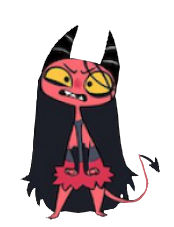
There's this kiddo from Loo Loo Land. I like her shapes as well, very exaggerated. As depicted here she kind of reminds me of some concept art girlies from the Art of Encanto book.
Actually, I think I have an image...

...I'm not the only one who sees it, right?
(Anyway, it's still available for free to view online. Very interesting stuff.)

Ahh... this guy. Or gal, actually. Turns out this is Skye Henwood's impsona, as well as my favorite character in Western Energy. Me and my friend were deadass ready to adopt her on sight. So tiny!! So shaped!! Look at that ridiculously huge bowtie. The littol suit. I want a pocket-sized imp now. Would carry them everywhere in my purse. Speaking of...

That's exactly what she did! Another crewsona (Sam Miller), and this design is incredibly slay. The feathers. The tail. Big, flowy, swooping shapes. (Not a big fan of the hands, though.) Very majestic creature overall.

Moving on to a few background Wrathians from Harvest Moon. She's a cutie. Not much else to be said. I like her outfit with the little boots and gloves as well as her pigtails.


I think these two could be related.

She looks so silly, I love her. Her hat and horns are disproportionately huge and it's precious.

Her name is Square, and she has major resting bitch face energy. I appreciate her instantly. (Long sleeved shirt + short shorts is a good combo.)
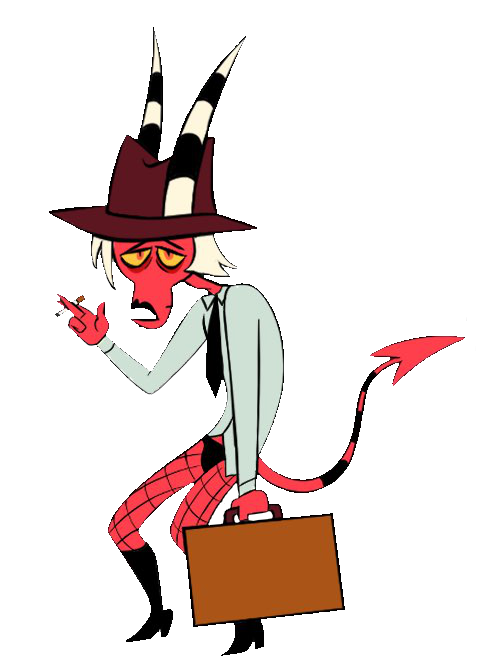
This guy from the Ozzie's elevator scene (Aspen) looks like he'd have quite the story to tell over a couple drinks of hard liquor. Slutty, but in a tired way. (A certain saxophonist cat from another piece of online media also fits that description.)

HER!! I love her so much. Everything about her honestly. The colors!! The legs!! The underbite!! She has no official name, but I call her Pomegranate. Or Pom for short. Got some of my own lore for her and everything.
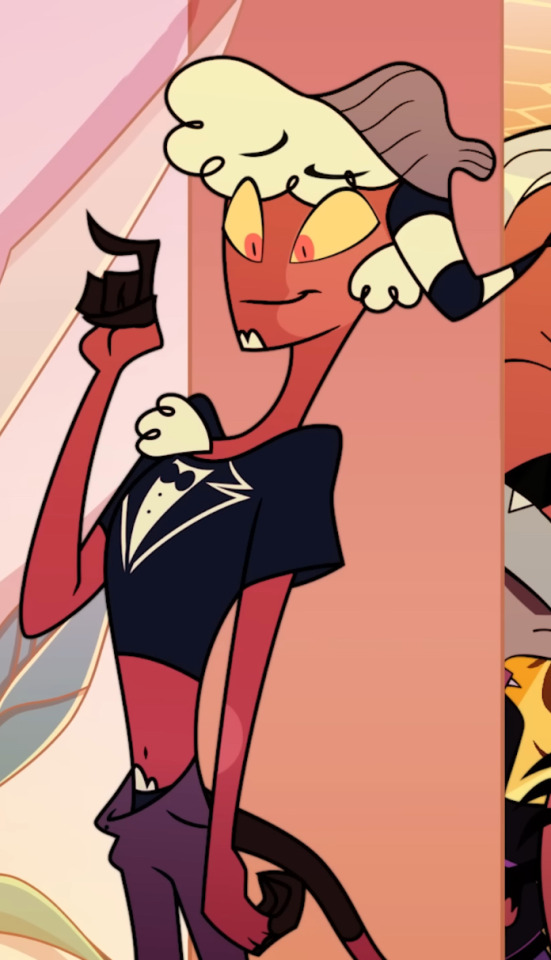
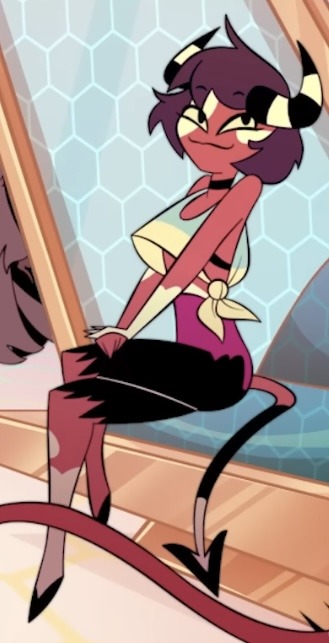
Haven't watched Queen Bee, so I didn't get to see Dennis in action, but from this still alone I conclude that he's pretty cute. (However dude could use to pull up his pants.) Didn't really deserve to get yelled at, anyhow. Justice for Dennis!
Though I do have an old Dennis character, and he's a dick, so maybe Blitzo was on to something.
I like the girlie on the right too. Women with :3 smiles automatically win me over. The ripped pants and loose tank top go well together, and the splotch of magenta on the waist isn't obnoxious.
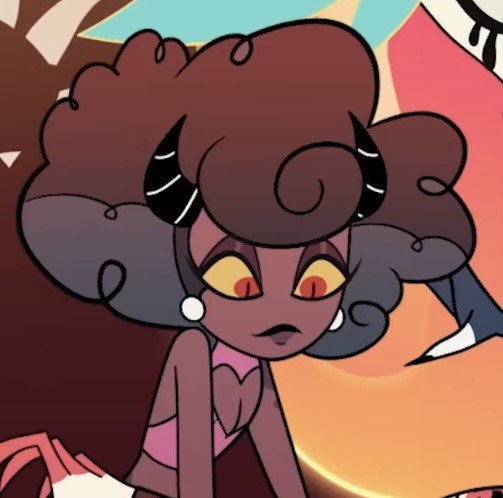
Mamma Mia, an imp with not purely and overwhelmingly red skin? What a spectacle. She looks way more like a black character than Velvette. And due to her subdued skin tone, the pink looks nice on her. (Which can't be said for Millie in one of the pieces of summer merch. Who thought pink on her was a good idea?!) Cool hair texture as well, feels very poofy.



Some bite-sized imp clowns from The Circus; their names are Eenie, Meenie, and Miney. How charming! Though, as I recall, doesn't that old children's rhyme go on to have four-

...Oh.
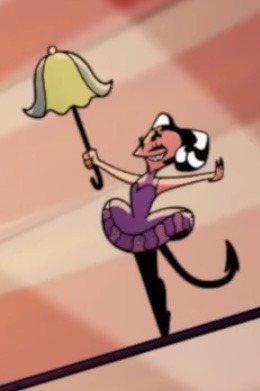
I think this might be Barbie Wire. We were never told explicitly, and she isn't even mentioned in the episode itself, but she looks closest to that design.
(Though I just noticed her horn stripes are too thick. Nevermind, then. Seems like she didn't even get that brief cameo in Blitzo's nearly episode-long childhood flashback despite being his twin sister, which should suggest that they were pretty close.)
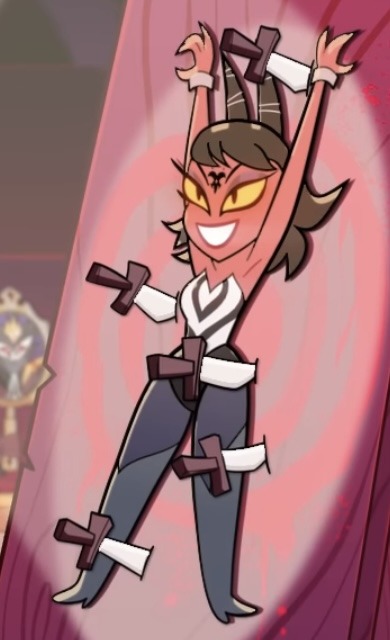
I like this chick, though.
And that's it for now! Let me know if you'd like to see a part two though I might just go ahead and make it anyway
#admin talks#helluva boss#character design#background characters#I'd be excited to do the sea creature demons from Envy. they all have pretty damn sick designs#disclaimer: I don't know anything about the crew members who made the sonas. in case they're problematic or anything
40 notes
·
View notes
Text
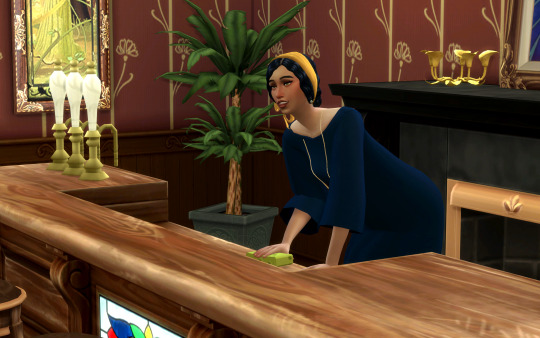
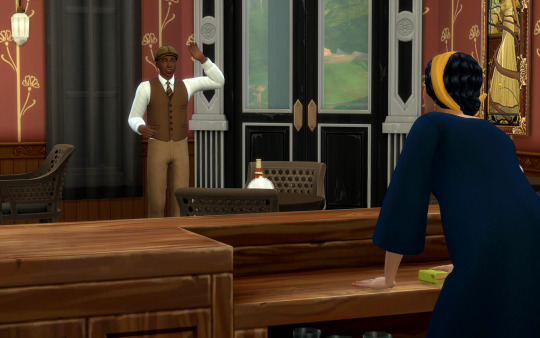
It was around noon and Jo was wiping down the bar, preparing for another night at the club. Zelda’s and Antoine’s first society party had been a smashing success, and the Mardi Gras crews were clamoring for them. She had easily booked them another party that night for top dollar.
As a replacement, Jo had hired a saxophonist she knew named Louis to play at the club for a few nights. Just as she looked up, he rushed into the bar, his round face flushed from the heat outside. “Hi-ya Jo!” He waved as soon as she saw him.

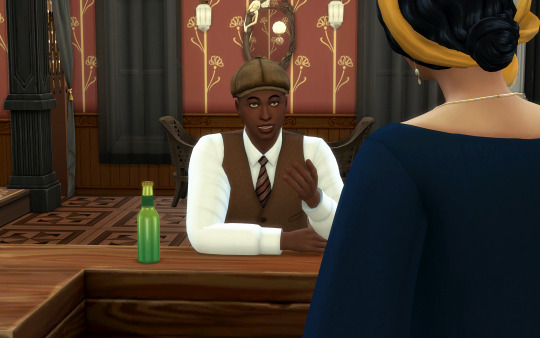
“Hey there, Louis. What about a drink to start the night?” Jo asked, holding up her finest bottle of beer.
He sat down at the bar, fiddling with his hands as he struggled to ask her something. She set the drink down in front of him, smiling warmly to encourage whatever it was he wanted to say.
“Say, Jo…” he began nervously, “Well everybody is talking about how easy you booked that party for Antoine. The thing is, I know how easy it is for you to get on with that…high society type. So me and my band was hoping you could do the same for us? Of course we can work out some sorta payment for you.”
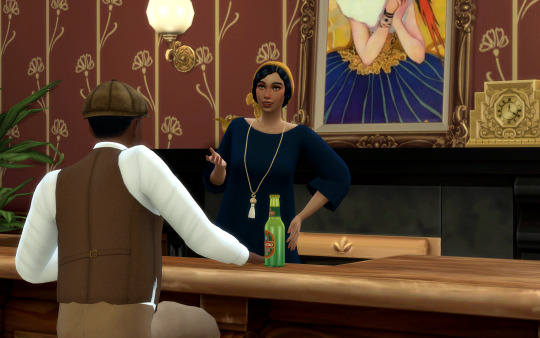
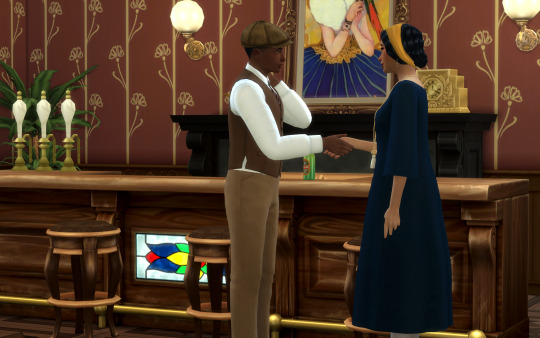


Jo let out one of her crooked grins, “You want me to manage you, eh?”
Louis laughed in turn, “Ha! I guess so, yeah! Whadya say?”
Jo barely even had to think about it. She had basically been managing this club for years, and booking Antoine and Zelda better and better gigs had been the best thrill she’d had in years. She rounded the bar and stuck out her hand, “I’d say we’ve got a deal Mr. Louis.”
#1922#ts4 decades challenge#sims 4 decades challenge#sims 4 historical#ts4 historical#sims 4 legacy#ts4 legacy#sims 4 story#ts4 story#the darlingtons#1920s#josephine duplanchier
74 notes
·
View notes
Text
Of Sorrows & Morals
// an old piece for @666calistaxx and her OCs Catherine and Jack, those two took over my brain for this to come to life.
// You can read the original formatted piece here

A hazy red mist washed over the curtain call, within the jazz club laid the pizazz of New York’s finest. The stage, held together by the wooden floor, flooded with the lights that stood overhead in lamps and chandeliers that stood a testament for the amount of wealth this place holds.
One such guest took himself into an uproar, soon followed en masse as the jazz band’s instrumentals brought themselves out one by one. Of course, the tradition follows that this is one of the most revered bands of the 1920s, with drums and saxophone work seen nowhere else within a 40 mile radius of New York.
The drummer, an ear or rhythm, was a top student at a notorious music school. The saxophonist, a student from the greats that are above his league, was an up and coming protégé amongst his peers.
The pianist, rumored to be ‘Joplin’s next in line’, with his ragtime infused genre, had clear influence from his namesake.
The trumpet player, a newcomer on the scene, had some of the best runs in terms of bar hopping recently, befriending more and more bandmates and scoring shows left and right.
And finally, the singer.
Known locally as “Catherine” or colloquially “Cash Candy Catherine”, she’s made a name for herself traveling through both speakeasies and jazz clubs alike to build a reputation for herself. Now she’s shooting her way to stardom, with all of the connections that span across the area like a widow’s web.
She slowly dazzled her way to the microphone stand, her elegance matched only by her soothing greeting.
“Ladies, gentlemen. Welcome to New York’s Rendezvous.”
The crowd erupted into a fit of laughter and applause, as Catherine stood back and closed her eyes. She’d hoped for this much of an audience for so long, and she’s here. Her hands rested towards her middle, clasping her midsection as she thought back to her first show…
Her first one with Jack, who was the only one who showed up for her rehearsal, and the only person who applauded after it was over. Despite everything, he had found a way again and again to support her. At the start, until now, he had been her supporter.
However, tonight, as she opened her eyes to scan the audience that slowly killed their applause, he was nowhere to be seen.
His signature glasses and brighter than usual smile didn’t fit the multitude of neutral faces that faced her.
Nonetheless, she kept on with her usual gig. She turned to the band, and signaled the band to start playing with a simple nod.
As a jazz tune, slow but certain, started up, she turned back to her audience. The applause died down completely, and all eyes were on her.
“This first one goes… out to him.”
She paused, not knowing how to take this in.
She kept scanning for a face. Any face. Something that took a hold of his shaders, his rather awkward pose, anything. Yet, she couldn’t find it.
“Wherever he may be.”
From the shadows of evil, into the spotlight, she stood there and cried out a lover’s lyricism. Her soothing voice assumed both a griever’s love and a symphonist’s concoction as she sang a cover of “Let Me Call You Sweetheart”. A succinct, powerful vocal that ruled over the instrumentals, Catherine poured her heart and soul into the performance of something less akin to a tribute and more of a final letter to her lover.
She reminisced about the conditions on which they met again, as she slowed down her performance to let the instrumentals run through the room. The perfect blend of such kept more and more patrons attentive towards the main stage, as she dove back out of the spotlight.
As the background music continued playing, she descended back into an earlier time, again back to the first ever performance. An improvised song on the spot, she was nervous back then. The audience was few and far inbetween, and Jack stood amongst them. Waiting within the crowd, and behind a pair of otherwise illegal shaders to an already illegal and shady practice to begin with: a speakeasy.
There was a deafening silence.
Playing tunes that never bore any semblance to anyone abroad.
Lyrics that never did anything more than add into the illicit nature of it all.
“Well well well… aren’t ya the pretty voice for a pretty lady?”
The man in a green suit complimented - in poor words - as he approached the singer.
“And who might you be?”
“Someone who just… wants a talk.”
The figure smiled, as it soon faded back to–
“Catherine? Cath. Cath!”
The drummer’s shaking, some members of the audience looking very disconcerted as some murmurs and whispers rose up during the commotion.
She stood there, concerned. Yet, the show she had promised needed to go on, as Catherine - underneath it all - soon disproved a dissonance to her delight.
She didn’t feel the need to think back to such events. Something that happened in the past stayed there, and whilst a cornerstone for her rising fame, she can’t reduce herself towards her vulnerabilities on these occasions.
Her singing, coupled by the band’s instantaneous improvisation, proved the crowd’s conversations wrong. Jazz continued onto the club’s nights, and her vocals stunned the night once again.
Never again will she be reminiscent of a tragic love, one burnt over the soothing smell of a Sunset Rose Cocktail.
12 notes
·
View notes
Text
A SERENE JAZZ MASTERPIECE TURNS 65
The best-selling and arguably the best-loved jazz album ever, Miles Davis’s Kind of Blue still has the power to awe.
MARCH 06, 2024

At a moment when jazz still loomed large in American culture, 1959 was an unusually monumental year. Those 12 months saw the release of four great and genre-altering albums: Charles Mingus’s Mingus Ah Um, Dave Brubeck’s Time Out (with its megahit “Take Five”), Ornette Coleman’s The Shape of Jazz to Come, and Miles Davis’s Kind of Blue. Sixty-five years on, the genre, though still filled with brilliant talent, has receded to niche status from the culture at large. What remains of that earthshaking year in jazz? “Take Five” has stayed a standard, a tune you might hear on TV or on the radio, a signifier of smooth and nostalgic cool. Mingus, the genius troublemaker, and Coleman, the free-jazz pioneer, remain revered by Those Who Know; their names are still familiar, but most of the music they made has been forgotten by the broader public. Yet Kind of Blue, arguably the best-selling and best-loved jazz album ever, endures—a record that still has the power to awe, that seems to exist outside of time. In a world of ceaseless tumult, its matchless serenity is more powerful than ever.
On the afternoon of Monday, March 2, 1959, seven musicians walked into Columbia Records’ 30th Street Studio, a cavernous former church just off Third Avenue, to begin recording an album. The LP, not yet named, was initially known as Columbia Project B 43079. The session’s leader—its artistic director, the man whose name would appear on the album cover—was Miles Davis. The other players were the members of Davis’s sextet: the saxophonists John Coltrane and Julian “Cannonball” Adderley, the bassist Paul Chambers, the drummer Jimmy Cobb, and the pianist Wynton Kelly. To the confusion and dismay of Kelly, who had taken a cab all the way from Brooklyn because he hated the subway, another piano player was also there: the band’s recently departed keyboardist, Bill Evans.
Every man in the studio had recorded many times before; nobody was expecting this time to be anything special. “Professionals,” Evans once said, “have to go in at 10 o’clock on a Wednesday and make a record and hope to catch a really good day.” On the face of it, there was nothing remarkable about Project B 43079. For the first track laid down that afternoon, a straight-ahead blues-based number that would later be named “Freddie Freeloader,” Kelly was at the keyboard. He was a joyous, selfless, highly adaptable player, and Davis, a canny leader, figured a blues piece would be a good way for the band to limber up for the more demanding material ahead—material that Evans, despite having quit the previous November due to burnout and a sick father, had a large part in shaping.
A highly trained classical pianist, the New Jersey–born Evans fell in love with jazz as a teenager and, after majoring in music at Southeastern Louisiana University, moved to New York in 1955 with the aim of making it or going home. Like many an apprentice, he booked a lot of dances and weddings, but one night, at the Village Vanguard, where he’d been hired to play between the sets of the world-famous Modern Jazz Quartet, he looked down at the end of the grand piano and saw Davis’s penetrating gaze fixed on him. A few months later, having forgotten all about the encounter, Evans was astonished to receive a phone call from the trumpeter: Could he make a gig in Philadelphia?
He made the gig and, just like that, became the only white musician in what was then the top small jazz band in America. It was a controversial hire. Evans, who was really white—bespectacled, professorial—incurred instant and widespread resentment among Black musicians and Black audiences. But Davis, though he could never quite stop hazing the pianist (“We don’t want no white opinions!” was one of his favorite zingers), made it clear that when it came to musicians, he was color-blind. And what he wanted from Evans was something very particular.
One piece that Davis became almost obsessed with was Arturo Benedetti Michelangeli’s 1957 recording of Maurice Ravel’s Piano Concerto in G. The work, inspired by Ravel’s triumphant 1928 tour of the U.S., was clearly influenced by the fast pace and openness of America: It shimmers with sprightly piccolo and bold trumpet sounds, and dances with unexpected notes and chord changes.
Davis wanted to put wide-open space into his music the way Ravel did. He wanted to move away from the familiar chord structures of jazz and use different scales the way Aram Khachaturian, with his love for Asian music, did. And Evans, unlike any other pianist working in jazz, could put these things onto the keyboard. His harmonic intelligence was profound; his touch on the keys was exquisitely sensitive. “I planned that album around the piano playing of Bill Evans,” Davis said.
But Davis wanted even more. Ever restless, he had wearied of playing songs—American Songbook standards and jazz originals alike—that were full of chords, and sought to simplify. He’d recently been bowled over by a Les Ballets Africains performance—by the look and rhythms of the dances, and by the music that accompanied them, especially the kalimba (or “finger piano”). He wanted to get those sounds into his new album, and he also wanted to incorporate a memory from his boyhood: the ghostly voices of Black gospel singers he’d heard in the distance on a nighttime walk back from church to his grandparents’ Arkansas farm.
In the end, Davis felt that he’d failed to get all he’d wanted into Kind of Blue. Over the next three decades, his perpetual artistic antsiness propelled him through evolving styles, into the blend of jazz and rock called fusion, and beyond. What’s more, Coltrane, Adderley, and Evans were bursting to move on and out and lead their own bands. Just 12 days after Kind of Blue’s final session, Coltrane would record his groundbreaking album Giant Steps, a hurdle toward the cosmic distances he would probe in the eight short years remaining to him. Cannonball, as soulful as Trane was boundary-bursting, would bring a new warmth to jazz with hits such as “Mercy, Mercy, Mercy.” And for the rest of his career, one sadly truncated by his drug use, Evans would pursue the trio format with subtle lyrical passion.
Yet for all the bottled-up dynamism in the studio during Kind of Blue’s two recording sessions, a profound, Zenlike quiet prevailed throughout. The essence of it can be heard in Evans and Chambers’s hushed, enigmatic opening notes on the album’s opening track, “So What,” a tune built on just two chords and containing, in Davis’s towering solo, one of the greatest melodies in all of music.
The majestic tranquility of Kind of Blue marks a kind of fermata in jazz. America’s great indigenous art had evolved from the exuberant transgressions of the 1920s to the danceable rhythms of the swing era to the prickly cubism of bebop. The cool (and warmth) that followed would then accelerate into the ’60s ever freer of melody and harmony before being smacked head-on by rock and roll—a collision it wouldn’t quite survive.
That charmed moment in the spring of 1959 was brief: Of the seven musicians present on that long-ago afternoon, only Miles Davis and Jimmy Cobb would live past their early 50s. Yet 65 years on, the music they all made, as eager as Davis was to put it behind him, stays with us. The album’s powerful and abiding mystique has made it widely beloved among musicians and music lovers of every category: jazz, rock, classical, rap. For those who don’t know it, it awaits you patiently; for those who do, it welcomes you back, again and again.
James Kaplan, a 2012 Guggenheim fellow, is a novelist, journalist, and biographer. His next book will be an examination of the world-changing creative partnership and tangled friendship of John Lennon and Paul McCartney.
5 notes
·
View notes
Text
Isaiah Collier - Parallel Universe - a hot direct-to-disc session for Night Dreamer, featuring Jimetta Rose on vocals
Multi-instrumentalist and composer Isaiah Collier connects with the divine ancestors on a transcendent Direct-To-Disc session, Parallel Universe. Chicago-based innovator and educator Isaiah Collier is opening up new dimensions in the jazzwise continuum. A saxophonist by trade whose multi-instrumental talents and compositional prowess have stretched the limits of the form, Parallel Universe represents a new chapter in Collier’s musical journey. Having already performed with a diverse range of musicians such as Chance The Rapper, Waddada Leo Smith, Chicago jazz royalty Angel Bat Dawid and his own band The Chosen Few, Collier’s latest work as a bandleader explores the shared musical heritage of the African diaspora with a sense of grace and assurance that belies his years.
Embracing the risk and vulnerability that comes with the live process, Collier and his band tapped into the frequencies of improvisation that fired up so many of the most timeless jazz recordings. “Recording direct-to-disc gave me a really fortunate opportunity to experience what our musical predecessors almost a hundred years ago were dealing with,” he explains. Name-checking Sun Ra, Ras G, J Dilla, Fela Kuti, Miles Davis, Gil Scott-Heron, Whitney Huston, Aaliyah and Frankie Knuckles, the opening of track of Parallel Universe imagines a genreless musical lineage that resonates with the polyphony of stories his band bring to the table, from Chicago and beyond.
Featuring gospel soul singer Jimetta Rose, AACM and former Art Ensemble of Chicago trumpet player Corey Wilkes, blues-rooted guitarist Michael Damani, regular collaborators Julian Davis Reid, James Russell Sims and Micah Collier, the 8-track album bristles with a sense of love and understanding between players at the top of their game.
“Give me that feeling that makes me feel like I’m alive,” Collier enthuses. “People can tell when you’re taking chances. I know that’s what everybody is looking for.”
Saxophone, Flute, Vocals, Keys - Isaiah Collier
Vocals - Jimetta Rose
Keys - Julian Reid
Bass - Micah Collier
Trumpet -Corey Wilkes
Drums - James Russell Sims
Guitar - Michael Damani
Kalimba - Ra
Additional Vocals - Sonny Daze
Recorded, mixed and mastered by Martijn Schouten
Cut by Patrick De Looper at Artone Studio
Produced by Sonny Daze
Recorded at Artone Studio on Thursday 9th & Friday 10th March 2023
#Bandcamp#Isaiah Collier#jazz#soul#female vocal#night dreamer#direct-to-disc#2023#chicago#jimetta rose
6 notes
·
View notes
Text
"Woodland Duet: Song of the Trees" | Original Song
I loved the Twelve Brooks one-shot from @worldsbeyondpod, and especially the music of the fabulous guest composer and saxophonist, Joseph David Spence. I've been thinking a lot lately about how nature can be represented through and with music (as have many for millennia, I'm sure).
On top of that, I love the idea that spirits in this story are so connected to breath and breathing, and as shown in this Tiktok from etymologynerd on the word "breathe," it derives from spirare in Latin meaning breath. So, being broadly inspired by Twelve Brooks, Eursulon's journey so far, and the delightful musical motif of the Parade of Beasts (first featured in the Children's adventure), I wrote this simple poem and folk song:
Take a quiet look around
And listen to the sound
Of the forest all around
There's music there
Hangin' sweetly in the air
Nature's chorus and fanfare
Refrain:
Melodies entwine
Hear the woods harmonize
With the breath of spirits divine
The buzzin' of the bees
And the rustlin' of the leaves
As the wind blows through the trees
The bullfrog croaks
As the fox tells his joke
'Neath the shade of the mighty oak
The song features a soprano/alto duet with additional harmony from the alto saxophone (I love its timbre as a representation of spirit's breath). The accompaniment leans into the folk/bluegrass style with banjo & honky tonk combined with simple percussion of cabasa and wood block.
No lyric video this time, but the song is available on YouTube along with a picture I took last spring of some turtles sunbathing on a log:
#original music#my music#wwwo#worlds beyond number#worldsbeyondpod#the wizard the witch and the wild one#fan song#wbn fanart#eursulon#twelve brooks#wbn
6 notes
·
View notes
Text
Top Gun Headcanons (that are just Goose and Carole but I am not apologising because I love them too much and just want to squish them both)
Carole can knit
She knit Bradley a load of hats and socks and jumpers when she was pregnant
Also Bradley was named after Carole's dad and they didn’t realise he'd be Bradley Bradshaw until after they’d signed the birth certificate
Goose can sew, Carole can't for shit
She saves a load of clothes for him to fix and whenever he's on leave or she visits him she brings a load of other clothes with her
Goose was taught piano by his maternal grandpa who was a jazz pianist and saxophonist who also did music lessons in his house. It started as his mum needing childcare for Goose and his sister while their dad was away with the marines and she was working
But Goose got good and also bored of syllabus music and the only other thing his grandpa had was jazz so Goose has a soft spot for it
Also, I headcanon that Goose's dad was in the marines which meant he had knowledge of the military but wasn't so knowledgeable that he knew of Duke Mitchell and could hold a grudge against Mav
Goose and Mav met when Goose's car broke down on his first day at the Academy and they went out for lunch after
Mav did engineering at a Uni near Annapolis because he wasn't allowed in the Academy but did OTS near the end of his degree and went to flight school with Goose
Carole's a librarian's assistant
She also has big reading glasses, when Goose first saw her in them he stopped functioning for a good five minutes
I will plug my Carole playlist
Goose and Carole are the first ones on the dance floor and last ones off it
This does not mean they can dance though
Goose's favourite place to be is in the not infrequent moments when both Bradley and Mav are sleeping in his and Carole's bed because of nightmares and he's flat on his back, Carole curled up on his left, Bradley on his chest and Mav on his arm to the right
Goose and Mav do cuddle platonically a lot, Goose's logic is, if they were awake they'd hug but he wants to comfort him and sleep so they'll cuddle instead
All the Bradshaws have birds associated with them, the obvious ones are Goose is a goose, Rooster's a chicken, the less obvious one is that Carole is a duck, specifically this one (an appleyard duck)

Thanks for reading this! I really like Goose and Carole is you can't tell
#carole bradshaw#nick bradshaw#nick goose bradshaw#goose bradshaw#goose top gun#pete mitchell#pete maverick mitchell#maverick mitchell#maverick top gun#goosecarole#carolegoose#goose x carole#carole x goose#top gun#top gun headcanons#bear writes#top gun (1986)#bradley bradshaw#bradley rooster bradshaw#rooster bradshaw#rooster top gun#baby rooster#platonic cuddling#platonic goosemav#i really want to squish goose and carole#just love them so much#especially carole#she doesn't get enough attention honestly
76 notes
·
View notes
Text
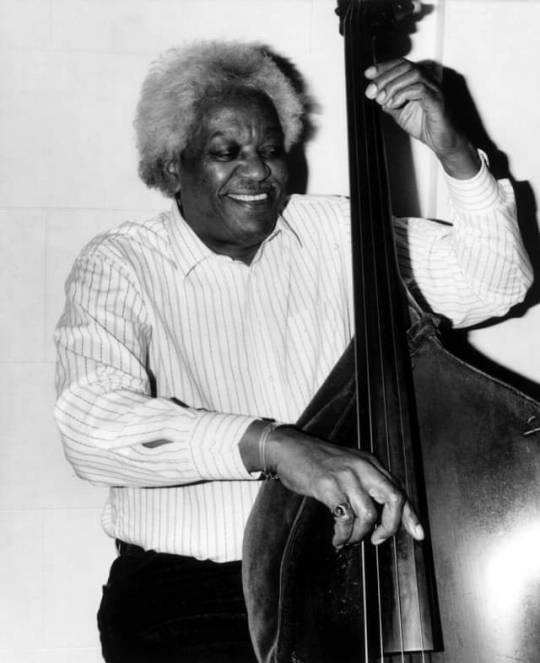
Regarded as the ‘Master of the Walking Bass,’ Leroy Vinnegar was a mainstay on jazz recording sessions from 1952 on where he was on over 600 dates. His signature walking bass was the foundation for his impeccable sense of swing, which has gone on to influence several generations of players.
Vinnegar was born into a musically inclined family in Indianapolis, Indiana, on July 13, 1928. His earliest musical education came from the radio, on which he listened religiously to the great bands of Duke Ellington and Count Basie. His two sisters played piano, and young Leroy thought that might be his instrument as well. “I tried my hand at piano,” he says, “and I would have been a nice piano player, had I stayed with it.” Things changed when he actually started playing with others, however. “The bass player used to leave his instrument at the house after we’d rehearse,” Vinnegar remembers, “and I just started messing with it, and the next thing you know I was playing the bass. We just got a communication going.”
When he was about 24, Vinnegar considered pursuing his muse on a grander scale. “I was getting ready to make my push,” he recalls. “I knew I had to get out of Indianapolis, so I could get my music career started. There were good musicians in Indianapolis, but I wanted to move up the ladder, so I figured I’d move to Chicago and tune up, and then I would go to New York.” That was 1952, and Vinnegar was shocked to discover that the Windy City was something far more challenging than a momentary stopover. “Little did I know Chicago was just as fast as New York,” he recollects with another hearty laugh. “I thought I would just go there and get ready for the big one. Little did I know I was walking into a lion’s den. They were there waiting for my ass.”
Vinnegar found himself to be “the tenth bass player on the totem pole” in a hierarchy of jazz bassists topped by Israel Crosby and Wilbur Ware. “When you’re new, you just have to wait your turn,” he says. But Vinnegar’s turn was not long in coming. “All the bass players were busy one week,” he remembers, “and somebody said, ‘Hey there’s a new bass player in town by the name of Leroy Vinnegar.’ ‘Well, how does he play, man?’ ‘They say he can play, you know?’ ‘Well, we ain’t heard him.’ ‘Let’s try him and see. There ain’t nobody else here we can get.’”
Soon, Vinnegar was playing in a band with Chicago’s great native tenor saxophonist Von Freeman, and then, with a brotherly boost from Israel Crosby, in the house rhythm section at the famous Bee Hive. There, he had the chance to work with Lester Young, Ben Webster, Johnny Griffin, Sonny Stitt, and others. “It’s hard to pinpoint a single influence,” Vinnegar says, “because everyone I played with or made a record with was such an influence on my career. But I think Art Tatum topped ’em all. He gave me such a nice compliment by wanting me to join his trio. I figured if Art Tatum asked me to join his trio, I must be doing something right.”
It was while playing with Bill Russo at the Blue Note, opposite Tatum, that Vinnegar was heard by the great pianist. “He heard me and wanted me to move to Los Angeles to join his trio,” the bassist recalls. “I was going to move anywhere.”
Shortly after he arrived in Southern California in 1954, Vinnegar insinuated himself indelibly into that scene. “They say it was much better in the ’40s, but for me, everything was happening,” he says, citing the L.A. presence of Dexter Gordon, Wardell Gray, Conte Candoli, Teddy Edwards, Frank Morgan, Hampton Hawes, Carl Perkins, Shorty Rogers, Zoot Sims, Stan Getz, Bud Powell, and many more. Ensconced again in a house rhythm section, this time at Jazz City, Vinnegar played regularly with pianists Kenny Drew, Carl Perkins, and Hampton Hawes, and drummers Lawrence Marable, Frank Butler, and for a while, Philly Joe Jones. He recorded with virtually everyone on the scene, formed a band with saxophonist Teddy Edwards, drummer Billy Higgins, and pianist Joe Castro, toured with Shelly Manne, and helped Les McCann put together his pioneering trio in 1960.
By then, at the urging of Contemporary’s Les Koenig, Vinnegar had already recorded his first albums as a leader"Leroy Walks!, in 1957, followed by Leroy Walks Again! “I was real nervous, wondering what I could do,” Vinnegar remembers. “Les said he wanted me to do songs that had the word ‘walk’ in them. That made it a little easier.”
The “walk,” of course, referred to the inimitably sturdy “walking” style that Vinnegar had perfected, a style he says came to him “because I couldn’t solo. I didn’t know the bass well enough, because I’d never studied it,” he elaborates. “I was just going by ear. I didn’t know the positions or the sound of the fiddle so whenever it got to me, I couldn’t solo and I just stayed right with the walking. It was a safe thing at the beginning, a sure shot, then it started developing into something. I found I had a lot of imagination for the walking bass.” That imagination had been fueled by singing bass in gospel choirs as a youngster, and it became invaluable for both Vinnegar and the musicians around him. “It gave other players a cushion to work off and it sort of woke up the bass players, too,” he says. “It gave people an understanding of what the bass could really do beyond going one, two, three, four.” Today, that understanding is as widespread as the respect that Vinnegar has garnered as the walking master.
Except for occasional recording sessions (such as Teddy Edwards’s breakthrough Mississippi Lad), festival appearances, and European tours, Vinnegar is content to play his regular gigs in Portland. “I’d been coming up to Oregon since 1973 and I fell in love with it,” he says. “Then I met some nice musicians up here and we started creating something, so I said I’ll stay right here. And I’m glad I did, because people up here accept real jazz.” And that’s what Vinnegar plays, with all the honesty and determination that “the Walker” has always embodied.
In 1995, the Oregon State Legislature honored him by proclaiming May 1 Leroy Vinnegar Day.
Leroy Vinnegar died August 3, 1999.
Source: AllAboutJazz/Wikipedia
14 notes
·
View notes
Text
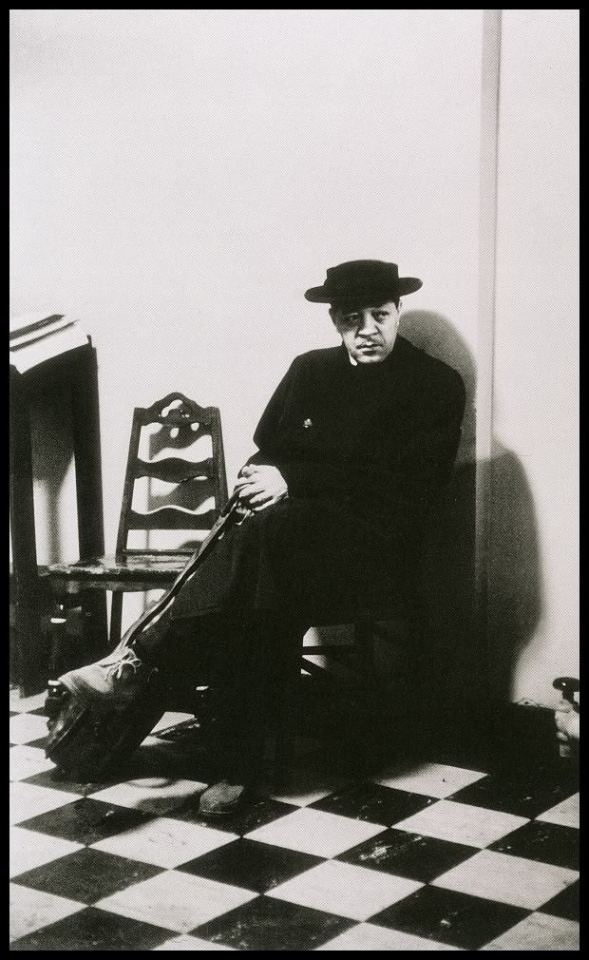
LESTER YOUNG, ALIAS PREZ
The man was a legend even among his peers. He was “Prez” for President. His playing is very relaxed. The saxophonist’s approach was clean and sophisticated. He played in Count Basie Orchestra for many years and left to play with different bands.
The tenor saxophonist collaborated with Charlie Parker, Kenny Clarke, Nat King Cole and many others. He’d play his songs with deep and lower riffs and he’d go up with a smooth effortless tone.
Lester Young was a great friend of Billie Holiday. They worked together and he was known for his way of speaking. Billie Holiday became “Lady Day” and bass players were called “Deep Sea divers”.
I would recommend “These foolish things” when the master is really on top of his game. Suave, assertive but always classy. That’s Lester Young forever.
---
L’homme était une légende parmi ses collègues. On le surnommait « Prez » pour président. Sa façon de jouer était décontractée. Son style direct et sophistiqué. Le saxophoniste a joué dans l’orchestre de Count Basie pendant des années et après avec différents groupes.
Il jouait le sax ténor et parmi les musiciens avec qui il jouait, on peut citer Charlie Parker, Kenny Clarke, Nat King Cole et plein d’autres. Il jouait avec des refrains bas, puis il pouvait remonter sans effort.
Lester Young était un grand ami de Billie Holiday. Ils ont travaillé ensemble et avec sa façon originale de parler, il l’appelait « Lady Day ». Tandis que les joueurs de bass s’appelaient « les plongeurs en mer profonde. »
Je recommande d’écouter « These Foolish things » quand le maître est au sommet de son art. Suave, sûr de lui mais toujours avec class.
23 notes
·
View notes
Text

Alto saxophonist Earl Bostic was a technical master of his instrument, yet remained somewhat underappreciated by jazz fans due to the string of simple, popular R&B/jump blues hits he recorded during his heyday in the '50s.
Born Eugene Earl Bostic in Tulsa, OK, on April 25, 1913, Bostic played around the Midwest during the early '30s, studied at Xavier University, and toured with several bands before moving to New York in 1938. There he played for Don Redman, Edgar Hayes, and Lionel Hampton, making his record debut with the latter in 1939. In the early '40s, he worked as an arranger and session musician, and began leading his own regular large group in 1945. Cutting back to a septet the next year, Bostic began recording regularly, scoring his first big hit with 1948's "Temptation." He soon signed with the King label, the home of most of his biggest jukebox hits, which usually featured a driving, heavy, R&B-ish beat and an alto sound that could be smooth and romantic or aggressive and bluesy.
In 1951, Bostic landed a number one R&B hit with "Flamingo," plus another Top Ten in "Sleep." Subsequent hits included "You Go to My Head" and "Cherokee." Bostic's bands became important training grounds for up-and-coming jazzmen like John Coltrane, Blue Mitchell, Stanley Turrentine, Benny Golson, Jaki Byard, and others. Unfortunately, Bostic suffered a heart attack in the late '50s, which kept him away from music for two years. He returned to performing in 1959, but didn't record quite as extensively; when he did record in the '60s, his sessions were more soul-jazz than the proto-R&B of old. On October 28, 1965, Bostic suffered a fatal heart attack while playing a hotel in Rochester, NY.
2 notes
·
View notes